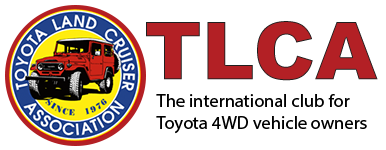NOVEMBER/DECEMBER 2014
A Dusty Trail of Memories by David Lee
[twocol_one]
Las Vegas, Nov. 5, 2013: Toyota unveiled the 2014 FJ Cruiser Trail Teams Ultimate Edition at a press conference held at the Specialty Equipment Manufacturer Association (SEMA) show. The FJ Trail Teams Ultimate Edition pays homage to the iconic FJ40 Land Cruiser. A white grille surround and “Heritage Blue” paint scheme show the link that exists between these vehicles—spanning decades from the 1960’s to the present.
At the same press conference, Toyota also announced the end of the line for the FJ Cruiser here in the U.S. The 2014 model— including 2,500 Ultimate Editions—will be the last model year sold. As an avid off-roader and Land Cruiser owner, I was saddened to hear this news. It didn’t take long for me to roll back the clock in my mind and revisit the time when the FJ Cruiser was brought to market.
For me, the FJ began as a personal desire to see Toyota produce a modern version of the old FJ40 Land Cruiser to compete with the 90-inch wheelbase Jeep products available at the time. I recall asking our Toyota executives about the possibility of building a modern FJ40 at a company outlook meeting held in 2005. They looked at me and grinned, then said there were no plans to do so.
It wasn’t long after when things began to take shape for the FJ Cruiser. My best friend in the company is Bruce Hunt. He is currently the Product Planning Manager for Trucks but back in the day, he was the planner for the 4Runner. It was from Bruce that I first got a glimpse of what was to come.
It was typical for us to have informal discussions on product content and features—usually focused on driveline components. We’d discuss the merits of different types of differentials, lockers, limited slips and the like, and how they might perform on products like the Tacoma, 4Runner or Land Cruiser. Bruce and I were discussing the use of locking differentials combined with a variation of traction control when he said he was working on a project for a new off-road vehicle…. “What…? Really…?” I was shocked. Then Bruce continued to say it was a short wheelbase vehicle…. After I was revived and propped back up at his desk, we continued our conversation.
It turned out that those executives at the meeting must have known something—that’s clearly why they were grinning at me! Bruce told me that he was the planner for the new short wheelbase vehicle and that the Chief Engineer was Akio Nishimura. I was now paying very close attention. Akio Nishimura is something of a legend within our walls and is known as a very enthusiastic off-roader. With Akio at the engineering helm and Bruce doing the planning work, I reckoned we would have a very interesting product for sale in the near future. I continued to ask Bruce questions about the dimensions of the truck and possible equipment and driveline configurations. I think Bruce had to finally kick me out of his office that day.
By the time Bruce and I spoke, the FJ Cruiser was actually down the road a bit in its development process. Bruce had already been involved for a while and had been quietly working with Mr. Nishimura and the Toyota Motor Sales Product Planning executives to bring the FJ to life. I sat down with Bruce recently and asked him about his experiences with the FJ Cruiser Project.
When asked how the project got off the ground, Bruce recalled, “The FJ type product was a concept we wanted to bring back for many years prior to my involvement. Several long range planning groups worked on projects and studies to convince our parent company that an FJ revival would be welcomed with good volume. It was after the formation of a new group within planning that the current FJ Cruiser concept was born. After revealing the concept in Chicago, the project was approved.”
Hunt went on to tell me how he got the assignment to work on the FJ Project: “I like to say I was doing a good job with my other projects and proved I could handle multiple vehicle planning. But it was more likely I had the least amount of work in the group and got lucky. I also had a good relationship with the Concept Planner, Akio Nishimura, who later became the Chief Engineer for the FJ Cruiser. I think this helped as well.”
As it was with many of us at Toyota Motor Sales, Hunt’s job was also affected by working on the FJ. I had to laugh when he told me about his times out test-driving early prototypes. “Off-road testing was probably my most memorable time working on the vehicles. Heck, it got me out of the office and allowed me to do some “genchi genbutsu” (go look and see). While testing on a few black diamond trails in California, we had the top off-road driver in the company help with the test mule. Since I was a novice offroader at best during that time, I watched as our top driver just slammed big Land Cruisers and our Prado (FJ) mule into ruts, rocks and berms—you name it—and was just amazed at this driving style. I thought to myself, ‘This guy sucks!’ Later that night at the test team dinner, the driver came over to me and said, ‘I heard you questioned my driving style.’ I was like, dang, I’m busted…. He told me his job was extremely important to our off-road vehicles. He went on to say his job was to break them (the vehicles) to find the weak points. ‘Once those points are located, then we can make enhancements and improve the performance and durability.’ He added, ‘We have Land Cruisers in some of the most remote places in the world and my job is to make sure those vehicles do not break.’ What an aha moment for me. Much respect for this man!”
Hunt went on to explain a bit about the teamwork between the Product Planning and Marketing Departments. “Frank (Gomi) and I worked together on Land Cruiser and Sienna prior to FJ. We had a great working relationship and worked as a team on the transition between planning and marketing. This is when I met Paul (Czaplicki). Paul was a good visionary on how to launch FJ. The decision was made to do grassroots marketing—prove it tours—to show folks FJ was for real and not just a styling exercise. The ‘prove it’ concept led to the creation of the Trail Teams. What a brilliant marketing move.”
New product development at Toyota involves many departments and their staff, including designers, engineers (both design and production specialties) and finally sales and marketing staff. Prototype testing is always important to vehicle development and the FJ Cruiser went through rigorous testing both in Japan and in the U.S. Here in the States, Joe Bacal was tasked with off-road testing the FJ. He put the prototypes through their paces in several locations—including the Rubicon Trail.
Bacal became involved with the FJ Project in 2005 and was asked to take a lead role in evaluating prototypes. Joe had been a test driver at Toyota’s proving grounds in Arizona for some time. Bacal had extensive experience driving on and off-road and over the years had shown his ability to give the engineers great feedback on suspension tuning as it related to overall ride quality and performance—both on pavement and off.
The marketing of a new product takes a lot of planning and coordination with the other departments involved. Within the Marketing Department, there are primary groups that work to help get a product off to a good start. A key role in this is the Product Vehicle Marketing and Communications Manager.
The FJ Cruiser was initially assigned to Frank Gomi—a veteran Product Manager. Gomi had experience marketing other off-road capable Toyota products and was a perfect fit for the job. Gomi got involved in the project in mid-2005 and worked hard to get the prototype FJ Cruiser ready for its introduction at the Chicago Auto Show in 2006. Gomi completed the early market research, which set the direction for the FJ Cruiser marketing strategy. The program targeted authentic offroaders and Gen X buyers who enjoyed offroading and customizing their vehicles.
Gomi explained that the FJ Cruiser had a very positive impact on the market. “Before the FJ Cruiser arrived, the only real McCoy was the Jeep Wrangler. So we added some spice to the body-on-frame SUV market. We truly believe that we created a stir in that market and created a thirst for true off-road capable vehicles.”
When asked how he felt about the end of the line for the FJ, Gomi said, “I’m sad and yet happy about it. This run of seven years or so puts a “collectable” cachet to the FJ Cruiser. Kind of like a “Limited” series and should create an aura of desirability to the series. It’s left the market place; however, it created another FJ legacy story.”
Entering the fray a bit later was Paul Czaplicki—a veteran of the Marketing and Product Planning Departments. Paul was tasked by Jim Farley—then the head of Marketing—to run with a program of his design that utilized the initial strategy put together by Frank Gomi. Czaplicki was given autonomy to market the FJ Cruiser as he saw fit. This was a bit unorthodox for the TMS Marketing Department at the time but he came to the job with experience as a Product Planner for the Land Cruiser—and as an off-road enthusiast. I think these talents and experience gave Farley the confidence he needed to allow Czaplicki to work unfettered.
As it was for me, Czaplicki got wind of the FJ Project as discussions with the Product Planning Department started to take place. Not long after, Farley brought him on board and turned him loose with the task of launching the FJ in a non-traditional manner. Farley had just come over to the Toyota Division after running the Scion Division and was known for launching products in unusual and creative ways.
Given complete creative control over the program and not a lot of time, Czaplicki set to work. Recently we sat down and I asked him about his experiences with the program. I was interested to know what information caused him to take the program in the directiovn he did.
“It (the FJ) was not well received in the initial clinic research,” Czaplicki said. “Consumer targets less than age thirty felt it was a rip off of Hummer. The targets over thirty remembered the FJ40 and had the opposite reaction. This key insight was why we launched targeting the true off-road enthusiasts first and leveraged black and white photography for our print ads. The idea was that we would appeal to true off-roaders with capability. If this group accepted the product, then the younger demographic would see it as a legitimate off-road truck.
“We wanted to avoid having the FJ labeled as some ‘cute and trendy’ truck. FJ Cruiser is a real off-roader, not just some fashion statement.
“Ironically, it was not as important to us if the enthusiast off roader purchased the truck; it was more important that they endorsed it as legitimate. They were the key opinion leaders that the under-forty crowd looked to.”
In retrospect, Gomi and Czaplicki were successful in gaining a level of acceptance for the FJ Cruiser in the off-road community. The FJ Cruiser Trail Teams Program was Czaplicki’s brainchild too.
“Butts in seats,” Czaplicki told me.
“Ride-and-drives are some of the most effective marketing tools we have. TV, web—it’s a passive sort of observation. Print also. Auto shows let you see the product but a ride-anddrive allows you to experience the product. I wanted ride-and-drives to be the cornerstone of the launch. If we were going to effectively convince the enthusiast off-roaders, you had to prove the product.”
I’ve always wanted to ask how the Trail Teams got their name, so I put the question to Paul. “In the event world, ‘street teams’ refers to any activation that goes out and tries to find the target buyer in a particular environment. The Trail Teams name was just an internal phrase I created to try to quickly explain the idea of taking the trucks to the enthusiasts in their environment. Internal marketing is often as important in selling a project as external marketing. The name immediately conveyed the concept. It’s a bit ironic that we ended up using it as the external communication name also.”
Gomi and Czaplicki essentially agree that the FJ Cruiser program proved that Toyota could launch and market a new vehicle type with virtually no use of traditional TV advertising. The initial sales targets for the FJ were easily exceeded—further proving the success of their unconventional program strategies. Hunt echoed this by saying that the program proved Toyota could do “niche.” Paul went on to say that the FJ Cruiser infused the lineup with excitement.
I became involved officially at the order of my Manager, Paul Williamsen. I was excited to be a part of the program. As a training guy and an enthusiast, this was a plum project! I had been quietly hoping I’d get the chance to work on the program. My conversations with Bruce Hunt had piqued my interest and enthusiasm and I couldn’t wait to get to work. Visions of testing and evaluating the FJ against various competitors in off-road conditions tantalized me! Like Hunt, I felt blessed to get this assignment!
Working closely with the key departments, we produced a product training course for the dealer sales associates, as well as introduced the FJ to the news media alongside Farley and Nishimura. I will always have fond memories of the FJ training program events. It was truly a pleasure to be able to talk to people about the FJ and how to use it off-road, as well as on-road. I spent hours describing the use of FJ’s rear locking differential and A-TRAC system, as well as its general dimensions, which made it so capable in the dirt. I can still see the smiles on people’s faces as they left a test course. The FJ seemed to impress those who drove it early on. It was very interesting to see how people reacted to it while driving it on-road too. The FJ’s looks steer drivers’ thoughts towards a rough and tumble vehicle that would have little on-road driving capability. In some ways, I think this was the FJ’s true surprise. Drivers were stunned after spending time in the FJ on a road course. They couldn’t believe how well it handled and rode. Some were further stunned to hear that it could tow up to 5,000 lbs. as well.
Throughout the training program development and execution, I consulted with the Product Planning and Marketing Departments as needed, offering my thoughts on topics ranging from vehicle feature content and operation to demonstration course design as well as assisting with ad brochure photo content. On the flipside, these groups made a lot of great suggestions on how we could enhance our program as well. This really was a multi-departmental effort that included a lot of back and forth dialogue.
Williamsen and I spent three years helping to train the Trail Teams drivers on Toyota products—alongside the renowned off-road instructor Bill Burke, who got them prepared to show off the FJ and assist potential and new owners in getting to know the FJ. It’s been a bit since I’ve spoken to Bill but I will never forget heading up to his place in Colorado with Bruce Hunt for a good dose of off-road training. I had a lot of experience driving in the California desert and sand dune areas, yet lacked rock crawling and woods trail driving experience. I can still clearly see the look on Hunt’s face as Burke asked him to drive the truck into an area that we both clearly didn’t think a vehicle could fit in. When we successfully drove out of that ravine, Hunt and I were hooked on what we were doing. I saw Burke as a 4×4 God that day and am still in awe of him as a driver—and as a man. Hunt and I came away from a week with Burke with a much more complete picture of how the FJ could be used off of the highway.
The Trail Teams drivers also benefitted from time spent with Burke. We couldn’t have had a better instructor for the Trail Teams Program. Burke took the time to teach each driver and blended a serious approach to driving safety with enthusiasm for the trail, the environment and the vehicles.
The drivers are a great bunch of folks and it was my pleasure to work with them. I still go off-roading with some of them to this day and I try to keep up with them as they continue to work and play outdoors. In fact, you can find Hunt, Czaplicki, Kevin Fukuchi (Hunt’s successor for FJ planning), Paul Williamsen, myself, and a fairly good-sized cadre of Toyota Corporate folks on the trails here in Southern California.
I asked Hunt how he felt about the end of the road for the FJ. I reckon his response says it all: “Get one now! It will be a collector’s item! I view it the same way I view the FJ40s riding down the road— dang, that is a cool ride. Keep driving them!”
Working on the FJ Cruiser Project was a fun time in my career and I truly felt like a kid in a candy store. This was one of those times in my life when there was some guilt over taking a paycheck for the work, as it was so fun and rewarding! The work and the friends I met will be a source of good memories for the rest of my life.
The FJ Cruiser changed the culture here at Toyota forever. Although this is the end of the line for the FJ, it’s hardly the end of the line for Toyota and its heritage of building offroad capable products. I asked all of the old team members how they felt about the future of off-roading from each of their perspectives. They responded with enthusiasm and support for the future products.
The FJ’s DNA will continue on in the new TRD Pro vehicles—Tundra, Tacoma and 4Runner. Each vehicle will have a unique blend of off-road components that include a suspension that is off-road biased, as well as traction systems and controls that are oriented towards the enthusiast. Hunt and Czaplicki continue to work on these products today. I’ve personally seen these trucks in testing and they are the real deal. So don’t shed too many tears over the departure of the FJ Cruiser, as Toyota will continue to bring the sort of products to market that keep us dirt-oriented folks excited about our hobby!
[/twocol_one]
[twocol_one_last]
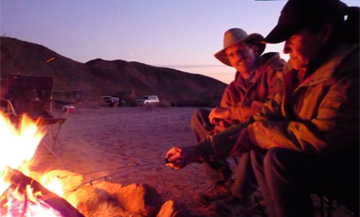
The author and spouse camping along the Mojave Road circa 2008. Photo courtesy of David Lee
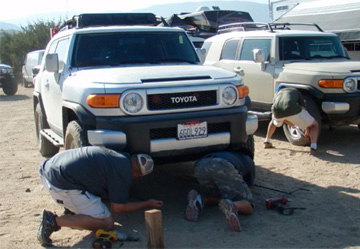
FJ Cruiser owners compete performing a tire change with minimal tools at an event in Hungry Valley, California. Photo courtesy of David Lee
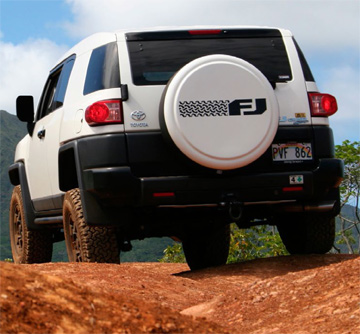
The FJ Cruiser left its footprint in Hawaii too, with a loyal community of owners who wheeled in some spectacular places. Photo by Todd Yee, Servco Pacific (Toyota’s distributor in Hawaii)
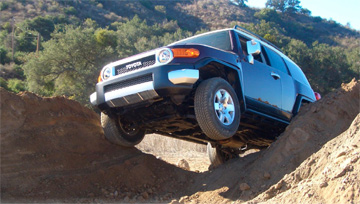
Toyota Corporate Product Training personnel get their skills sharpened at the FJ Cruiser training event near Irvine Lake, California. Photo courtesy of David Lee
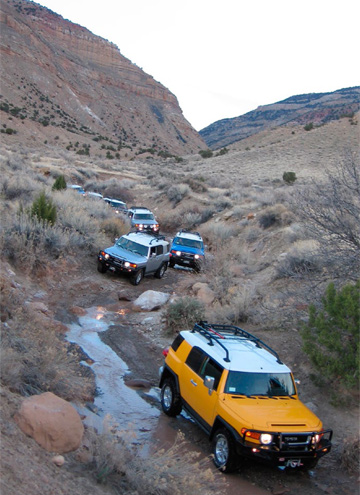
FJ Cruisers in action during the inaugural Trail Teams training in Colorado. Photo by Paul Williamsen
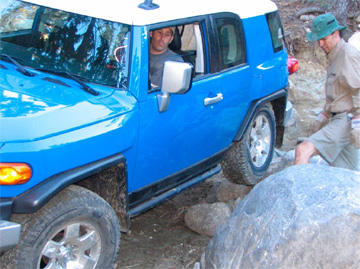
Joe Bacal negotiates his way through the Rubicon Trail. Photo courtesy of Joe Bacal
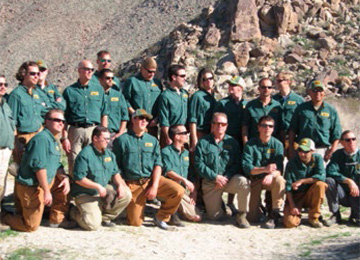
The Trail Teams drivers during training for the third year of the program. Photo courtesy of David Lee
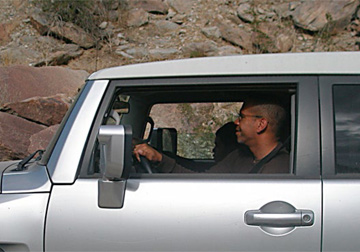
Kevin Fukuchi (the second FJ planner) and the author out with the Toyota teams near Borrego Springs, California. Photo by Bruce Hunt
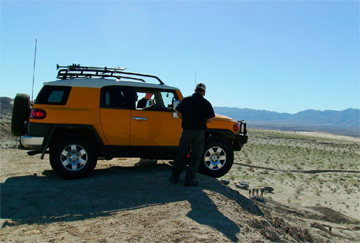
A Trail Teams driver contemplates a steep descent at Borrego Springs, California. Photo courtesy of David Lee
David Lee is a senior Product Education Administrator for the Toyota Product Sales and Engagement Department. He has created the sales training programs for a variety of Toyota vehicles including the Sequoia SUV, the 200 series Land Cruiser, the two most recent generations of 4Runner, the current Tacoma pickup and the previous generation Tundra. He continues to develop programs for the Prius family and Avalon sedan and drives extensively in California wilderness areas as well as on various corporate test tracks and courses.
[/twocol_one_last]
